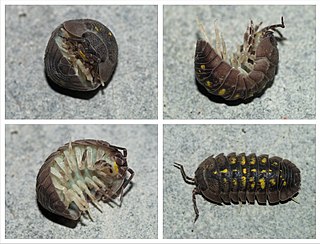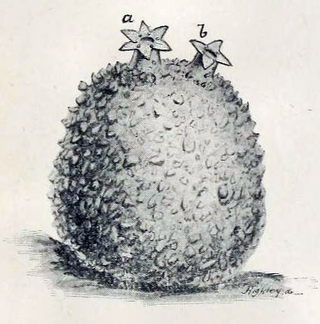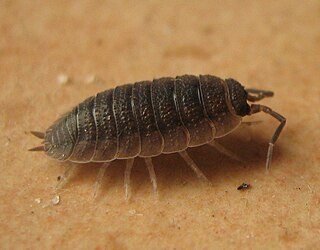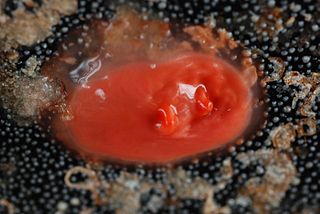
Armadillidium is a genus of the small terrestrial crustacean known as the woodlouse. Armadillidium are also commonly known as pill woodlice, leg pebbles, pill bugs, roly-poly, or potato bugs, and are often confused with pill millipedes such as Glomeris marginata. They are characterised by their ability to roll into a ball ("volvation") when disturbed.

Molgula, or sea grapes, are very common, globular, individual marine tunicates roughly the size of grapes.

Haplophthalmus is a genus of woodlice in family Trichoniscidae. It contains 47 described species, of which two are listed as vulnerable species on the IUCN Red List – Haplophthalmus abbreviatus and Haplophthalmus rhinoceros.

Porcellio is a genus of woodlice in the family Porcellionidae. These crustaceans are found essentially worldwide. A well-known species is the common rough woodlouse, Porcellio scaber.
Mahehia is a genus of woodlice in the family Porcellionidae, which is endemic to the Seychelles. It contains the following species:

Philosciidae are a family of woodlice. They occur almost everywhere on earth, with most species found in (sub)tropical America, Africa and Oceania, and only a few in the Holarctic.

Gustav Henrik Andreas Budde-Lund was a Danish invertebrate zoologist. In 1868, he co-founded the Entomologisk Forening, alongside Rasmus William Traugott Schlick, Carl August Møller, Andreas Haas and Ivar Frederik Christian Ammitzbøll. He was a student of entomologist J. C. Schiødte, and became a leading authority on terrestrial isopods, describing over 70 genera and around 500 species. He married in 1875 and in 1885 produced his seminal work Crustacea Isopoda terrestria. The woodlouse genus Buddelundiella was named in Budde-Lund's honour by Filippo Silvestri in 1897.

Stolidobranchia is an order of tunicates in the class Ascidiacea. The group includes both colonial and solitary animals. They are distinguished from other tunicates by the presence of folded pharyngeal baskets. This provides the etymology of their name: in ancient Greek, στολίς, ίδος means the "fold" of a cloth. Stolidobranchian sea squirts are also characterized by the complete absence of an abdomen. The abdominal organs of other tunicates are instead located to one side of the pharyngeal basket in this group.
Lund is a common surname, principally of Danish, Swedish, Norwegian and English origin. As a common noun lund means grove in all North Germanic languages. Lund can be English and can be Scandinavian surname. Also Scandinavian and English surnames can have a particle lund. Lund may refer to:

Trachelipus is a genus of woodlice in the family Trachelipodidae, containing the following species:

Armadillidae is a family of woodlice, comprising around 80 genera and 700 species. It is the largest family of Oniscidea, and one of the most species-rich families of the entire Isopoda. Most of the armadillidae taxa are not monophyletic. Armadillids generally have a strongly convex body shape, with some rather shallowly convex. Like members of the woodlice family Armadillidiidae, armadillids are capable of enrolling into a sphere (conglobation), and are commonly known as pill bugs. Some species, however, have secondarily lost their conglobation ability. For example, a species exist in which the males lack the inner face of the coxal plates and are therefore unable to conglobate. Armadillids differ from the Armadillidiidae in that the antennae are fully enclosed within the sphere.

Cnemidocarpa is a genus of ascidian tunicates in the family Styelidae.

Tylos is a genus of woodlice in the family Tylidae. There are at least 20 described species in Tylos. All the species in this family can roll up into a perfect ball and live on sandy beaches.
Alloniscus is the sole genus in the woodlice family Alloniscidae. There are more than 20 described species in Alloniscus.

Armadilloniscus is a genus of woodlice in the family Detonidae. There are more than 30 described species in Armadilloniscus.

Philoscia is a genus of woodlice in the family Philosciidae. There are more than 80 described species in Philoscia.

Armadillo is a genus of isopods belonging to the family Armadillidae.
Schoeblia is a genus of crustaceans belonging to the monotypic family Schoebliidae.














